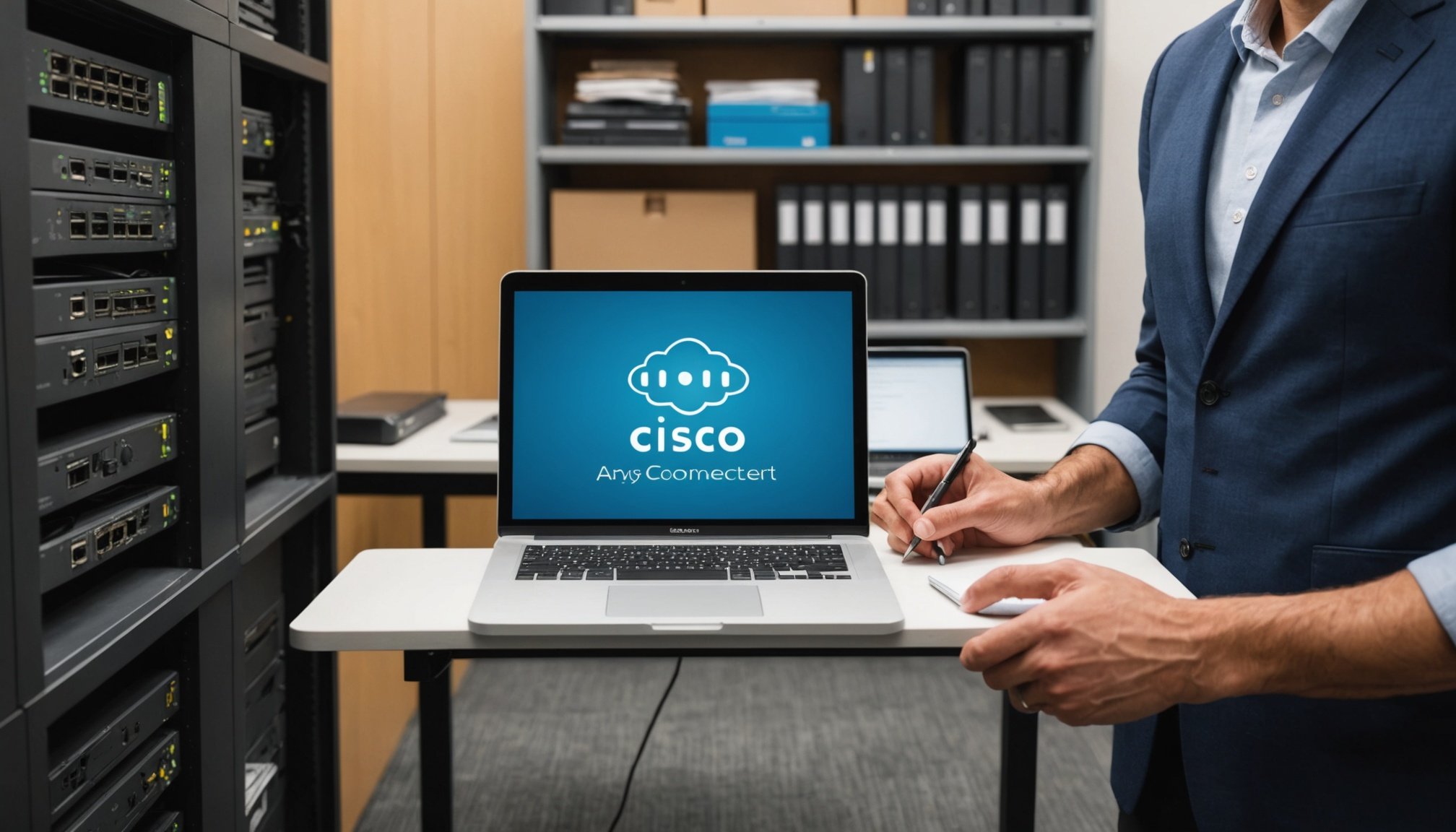Overview of Cisco AnyConnect VPN
Cisco AnyConnect is a comprehensive VPN solution designed to secure enterprise networks by providing remote connectivity to corporate resources. With cybersecurity becoming ever more critical, the role of VPNs in protecting enterprise data cannot be overstated. Cisco AnyConnect addresses this by creating a secure, encrypted tunnel for data transmission, safeguarding sensitive information from potential breaches.
Key features of Cisco AnyConnect include intelligent split tunneling, endpoint posture assessments, and robust authentication options. These features ensure that while users access the necessary resources, network performance is not compromised, providing a seamless and secure user experience.
This might interest you : Revamp your google calendar with vibrant color additions
The significance of integrating such advanced VPN solutions within an enterprise infrastructure is paramount. By leveraging VPN technologies like Cisco AnyConnect, organizations can ensure secure, remote access, enabling employees to work efficiently from any location. Furthermore, AnyConnect’s compatibility with multiple device types and operating systems makes it a versatile tool for diverse enterprise environments.
In conclusion, using Cisco AnyConnect as part of a network security strategy not only bolsters data protection but also enhances operational continuity through secure and reliable remote access. This positions Cisco AnyConnect as a vital component in modern enterprise cybersecurity arsenals.
This might interest you : Enhance your google calendar: a simple guide to adding colors
Setting Up Cisco AnyConnect
Configuring Cisco AnyConnect requires some initial steps to ensure a smooth installation. First, verify the technical prerequisites including operating system compatibility and network settings alignment. Ensuring these elements meet the basic requirements streamlines the process and prevents potential installation hitches.
Below are the initial installation steps. Start by downloading the Cisco AnyConnect installer from a trusted source or the official Cisco website. Once the download is complete, run the installer and follow the on-screen prompts to initiate the installation process. Pay close attention to any permission requests, as these are integral to granting the VPN proper network access.
After successful installation, the focus shifts to initial configuration and settings adjustment. Launch Cisco AnyConnect and proceed to create a connection profile, entering the server details provided by your network administrator. This step is crucial in linking the client with the enterprise VPN server.
Finally, optimise configuration settings for a secure and efficient connection. Key adjustments may involve enabling features like split-tunneling and setting preferred DNS servers. Through these steps, organisations can ensure a robust and secure remote access setup, enhancing their enterprise network security posture.
Security Protocols and Encryption
Security protocols are integral to Cisco AnyConnect, aiming to maintain the integrity of data transmission. The use of advanced encryption standards ensures that data is protected from unauthorised access, making this VPN solution a reliable choice for enterprise security.
Overview of Security Protocols
Cisco AnyConnect utilises several security protocols to create secure connections across diverse network environments. Among these are SSL (Secure Sockets Layer) and IPSec (Internet Protocol Security), which are renowned for their ability to authenticate and encrypt data exchanges effectively.
Importance of Encryption
Encryption is crucial in safeguarding data, especially in a corporate context where sensitive information is at play. By employing robust encryption standards, Cisco AnyConnect protects data from interception during transmission, ensuring only authorised parties can access it.
Best Practices for Secure Connections
To reinforce data security, consider the following practices:
- Regularly update the software to safeguard against vulnerabilities.
- Employ multi-factor authentication methods to further secure user access.
- Conduct periodic security audits to identify and mitigate potential risks.
These best practices, combined with Cisco AnyConnect’s inherent security features, provide a comprehensive shield against cyber threats, helping enterprises maintain their infrastructure integrity.
Integration with Existing Infrastructure
Integrating Cisco AnyConnect into an established network infrastructure involves careful consideration of multiple factors to ensure seamless compatibility and enhanced security. First, assess the network architecture to determine the level of integration complexity. The VPN should support a wide range of network environments, facilitating the ease of adaptation to existing systems. Particular attention should be given to the network’s bandwidth capacity, as the VPN usage might impact network performance and require adjustments or upgrades to handle increased traffic efficiently.
For enterprises, ensuring systems compatibility is key. Cisco AnyConnect is designed to work with diverse hardware and operating systems, providing flexibility in integration. Nonetheless, verify that all components of the network infrastructure, including firewalls and routers, are compatible and can securely interface with AnyConnect’s protocols.
Real-world integration examples, such as those within multi-branch corporations, demonstrate how AnyConnect can unify resource access across geographically spread locations. Successful integrations typically involve proactive planning and phased deployment strategies to monitor and adjust as necessary. Leveraging Cisco’s robust support resources can also mitigate potential challenges during this process, ensuring a secure and efficient integration.
User Management and Access Control
Effectively managing user access is crucial for maintaining network security with Cisco AnyConnect. Establishing user roles is fundamental, allowing administrators to define permissions tailored to the needs and responsibilities of different personnel. By categorising users based on their roles, organisations can easily manage access to sensitive resources.
Authentication Methods
AnyConnect supports numerous authentication methods, enhancing security by requiring users to provide valid credentials before accessing the network. Common methods include single sign-on (SSO), RADIUS, and multi-factor authentication (MFA). MFA is highly recommended as it adds an additional layer of security by requiring users to verify their identity through multiple means.
Policies for User Access Control
Implementing rigorous user access control policies helps regulate how and when users can connect to the VPN, ensuring that access is only granted to authorised individuals under specific conditions. Such policies may include restrictions based on time of day, location, or device compliance.
In summary, solid user management and robust access control protocols are key to maintaining network integrity with Cisco AnyConnect. By leveraging these strategies, organisations can significantly reduce the risk of unauthorised access and enhance their overall security posture.
Performance Optimization
Enhancing the performance of Cisco AnyConnect is vital for maintaining network efficiency and user satisfaction. Monitoring key performance metrics is the first step in identifying areas needing improvement. Administrators should regularly check data throughput, connection latency, and user load to ensure optimal conditions.
Employing optimization techniques can significantly boost performance. It’s advisable to implement Quality of Service (QoS) protocols to prioritize bandwidth for critical applications. This ensures essential services remain unaffected by high traffic volumes. Additionally, consider enabling split tunneling, allowing direct access to public networks while maintaining secure connections for corporate resources.
Troubleshooting common performance issues is crucial to maintain smooth operations. Often, slow connection speeds are attributed to high server loads or network congestion. In such cases, re-evaluating server distribution and upgrading bandwidth capabilities may be necessary.
Further, tools such as packet analyzers can help pinpoint bottlenecks and data packet losses. These insights assist in crafting precise solutions tailored to specific network demands. For more complex scenarios, leveraging Cisco’s support resources provides additional guidance and addresses persistent issues effectively, ensuring that Cisco AnyConnect delivers top-tier performance across enterprise environments.
Troubleshooting Common Issues
Effective VPN troubleshooting is crucial for resolving connectivity challenges with Cisco AnyConnect. Addressing common issues ensures uninterrupted access and enhances user satisfaction. If users experience recurrent disconnections, a sound practice is to check for network congestion. High traffic can lead to unstable connections, making bandwidth adjustments necessary.
Begin by identifying whether the issue lies with client or server settings. Incorrect configurations often result in failed connections. Verifying that the client’s device settings align with Cisco AnyConnect’s requirements can solve many problems. For server-side issues, checking the protocol settings and ensuring compatibility with all network components is recommended.
The use of monitoring tools enhances troubleshooting efficiency. Network diagnostic tools, including packet analyzers, help pinpoint where data transfer interruptions occur, allowing for precise rectification measures. Additionally, updating VPN client software regularly guards against known vulnerabilities, improving overall stability.
For persistent connectivity hurdles beyond basic solutions, engaging Cisco’s support services can provide comprehensive guidance and resources. They deliver expert advice tailored to complex scenarios, ensuring that Cisco AnyConnect functions optimally within any enterprise network framework. Utilizing these practices refines issues resolution, ultimately supporting robust and reliable corporate VPN operations.
Real-World Scenarios and Use Cases
In today’s digital landscape, Cisco AnyConnect VPN is pivotal for enabling remote work and ensuring data protection across various sectors. Its enterprise solutions are essential for organisations needing reliable, secure access to their network resources from anywhere. A critical VPN use case is facilitating remote workforces, allowing employees to connect safely to company systems from home or on the go.
Businesses often deploy Cisco AnyConnect to support secure enterprise scenarios, ensuring only authorised devices and users gain network access. For example, hospitals utilise this VPN to allow medical professionals secure access to patient records and healthcare systems while complying with strict data regulations. Financial institutions, a sector heavily reliant on VPN security, use AnyConnect to encrypt sensitive transactions and communications, protecting them from cyber threats.
From educational institutions to multinational corporations, Cisco AnyConnect’s real-world applications are diverse. Universities, for instance, implement it to offer students and faculty secure access to online resources. These practical applications highlight the lessons learned from different industries: the importance of robust VPN solutions tailored to specific organisational needs. By analysing these diverse scenarios, enterprises can better understand how Cisco AnyConnect supports seamless operations and enhances their overall cybersecurity framework.










